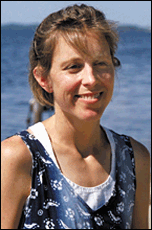|
|
 |
Study intends to solve seagrass mysteryMONITORING PROGRAM: Acres havevanished; grant opens door to learning why.  (Photo: Linda Fitzhugh, coordinator of a seagrass monitoring program, hopes the program will help foster awareness and appreciation of seagrasses and their role in the bay ecosystem. News Herald Photo: Tom Needham.) (Photo: Linda Fitzhugh, coordinator of a seagrass monitoring program, hopes the program will help foster awareness and appreciation of seagrasses and their role in the bay ecosystem. News Herald Photo: Tom Needham.)KENDALL MIDDLEMAS The News Herald Since the 1970s, more than 300 acres of seagrass have disappeared from West Bay, and nobody knows exactly why. Local environmentalists hope a planned seagrass monitoring program will help them find the answer. Thanks to a $25,000 grant, the St. Andrew Bay Resource Management Association, in partnership with Gulf Coast Community College, will be able to buy equipment to monitor the density and distribution of seagrass in two sections of the bay system. "We are going to focus on West Bay, of course, where we've had 300 acres lost," said Linda Fitzhugh, coordinator of the monitoring program and an assistant professor of biology at Gulf Coast. The other monitoring location is near Shell Island and Grand Lagoon - an area of heavy boat traffic. Now, the RMA and GCCC need volunteers to help them with the monitoring. They will hold a training session on Saturday to teach volunteers how to use the equipment. Volunteers must commit one day a year - this year it will be a Saturday in mid- to late September. The monitoring essentially consists of laying a 1-square-meter rack over a section of seagrass. The rack has 100 cells, and monitors will count the number of cells that have seagrass shooting through them. From that information, they will derive a percentage of seagrass coverage in the area. They also will measure the height of the seagrass shoots. Measurements will be taken every 20 meters. The program also will include water-quality testing and a measurement of the composition of different seagrass species. The grant - awarded by the National Oceanic and Atmospheric Administration and administered by the Florida Department of Community Affairs' Coastal Management Program - requires a 50 percent match. RMA and Gulf Coast are providing an "in-kind" match by supplying boats, volunteers and other equipment. RMA and Gulf Coast plan to use a portion of the grant money to produce two educational videos about seagrass. The grant is good for one year, but Fitzhugh hopes to reapply and receive the money for several consecutive years. With three to five years of monitoring, biologists should be able to get a good idea about the health and abundance of seagrass in the St. Andrew Bay system. "By then we'll see if our seagrass beds are shrinking in size or if seagrass beds are getting more sparse," Fitzhugh said. "We're hoping they'll all be the same." Baseline data that will allow biologists to spot trends in seagrass losses and to begin making plans for seagrass restoration in areas of heavy loss. Fitzhugh hopes the program will have additional benefits, including fostering awareness and appreciation of seagrasses and their role in the ecosystem. "People relate more to living things," she said. "That's why I'd like to get more people in the water doing seagrass monitoring." Seagrass beds are a vital part of the bay ecosystem. Their presence - or absence - is in many ways a measure of the bay's general health. Seagrasses serve as nursery ground and shelter to dozens of species. Dozens of others feed in and around the seagrass beds. Boats pose one of the greatest threats to seagrass beds. In a matter of seconds, a boat propeller can cut through a section of seagrass and literally tear the plants up by their roots. It takes years for the seagrasses to grow back, if they grow back at all. Biologists estimate that more than 50 percent of the seagrasses in the St. Andrew Bay system have prop scars. The volunteer training session will be from 9 a.m. to noon on Saturday at the Florida State University-Panama City Campus conference center. Volunteers should wear bathing suits and wading shoes, and should bring snorkeling equipment if they have it. Adults must accompany children under the age of 18. RMA members will supply boats, and Fitzhugh has been in contact with the Coast Guard Auxiliary about providing safety patrols around the monitoring stations. For more information, contact Fitzhugh at 872-3488, or by e-mail at fitzhugh@knology.net The writer can be contacted at kmiddlemas@pcnh.com
Copyright Notice |